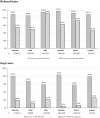Understanding communication breakdown in the outpatient referral process in Latin America: a cross-sectional study on the use of clinical correspondence in public healthcare networks of six countries
- PMID: 29452401
- PMCID: PMC5894081
- DOI: 10.1093/heapol/czy016
Understanding communication breakdown in the outpatient referral process in Latin America: a cross-sectional study on the use of clinical correspondence in public healthcare networks of six countries
Abstract
An adequate use of referral and reply letters-the main form of communication between primary care (PC) and out-patient secondary care (SC)-helps to avoid medical errors, test duplications and delays in diagnosis. However, it has been little studied to date in Latin America. The aim is to determine the level and characteristics of PC and SC doctors' use of referral and reply letters and to explore influencing factors in public healthcare networks of Argentina, Brazil, Chile, Colombia, Mexico and Uruguay. A cross-sectional study was conducted through a survey of PC and SC doctors working in public healthcare networks (348 doctors per country). The COORDENA questionnaire was applied to measure the frequency of use and receipt of referral and reply letters, quality of contents, timeliness and difficulties in using them. Descriptive analyses were conducted and a multivariate logistic regression model was generated to assess the relationship between frequent use and associated factors. The great majority of doctors claim that they send referral letters to the other level. However, only half of SC doctors (a higher proportion in Chile and Mexico) report that they receive referral letters and <20% of PC doctors receive a reply from specialists. Insufficient recording of data is reported in terms of medical history, tests and medication and the reason for referral. The factor associated with frequent use of the referral letter is doctors' age, while the use of reply letters is associated with identifying PC doctors as care coordinators, knowing them and trusting in their clinical skills, and receiving referral letters. Significant problems are revealed in the use of referral and reply letters which may affect quality of care. Multifaceted strategies are required that foster a direct contact between doctors and a better understanding of the PC-based model.
Figures
Similar articles
-
Doctors' experience of coordination across care levels and associated factors. A cross-sectional study in public healthcare networks of six Latin American countries.Soc Sci Med. 2017 Jun;182:10-19. doi: 10.1016/j.socscimed.2017.04.001. Epub 2017 Apr 3. Soc Sci Med. 2017. PMID: 28411523
-
Relational Continuity of Chronic Patients with Primary and Secondary Care Doctors: A Study of Public Healthcare Networks of Six Latin American Countries.Int J Environ Res Public Health. 2022 Oct 11;19(20):13008. doi: 10.3390/ijerph192013008. Int J Environ Res Public Health. 2022. PMID: 36293587 Free PMC article.
-
Changes in knowledge and use of clinical coordination mechanisms between care levels in healthcare networks of Colombia.Int J Health Plann Manage. 2021 Jan;36(1):134-150. doi: 10.1002/hpm.3073. Epub 2020 Sep 20. Int J Health Plann Manage. 2021. PMID: 32954542
-
Use of referral reply letters for continuing medical education: a review.J Contin Educ Health Prof. 2002 Fall;22(4):222-9. doi: 10.1002/chp.1340220406. J Contin Educ Health Prof. 2002. PMID: 12613057 Review.
-
Valued Components of a Consultant Letter from Referring Physicians' Perspective: a Systematic Literature Synthesis.J Gen Intern Med. 2018 Jun;33(6):948-954. doi: 10.1007/s11606-018-4356-3. Epub 2018 Mar 5. J Gen Intern Med. 2018. PMID: 29508258 Free PMC article.
Cited by
-
Understanding the factors influencing the implementation of participatory interventions to improve care coordination. An analytical framework based on an evaluation in Latin America.Health Policy Plan. 2020 Oct 1;35(8):962-972. doi: 10.1093/heapol/czaa066. Health Policy Plan. 2020. PMID: 32743666 Free PMC article.
-
[What do doctors suggest to improve coordination between levels? Results in six Latin American countries].Rev Salud Publica (Bogota). 2024 Jan 1;26(1):106956. doi: 10.15446/rsap.V26n1.106956. eCollection 2024 Feb. Rev Salud Publica (Bogota). 2024. PMID: 40099192 Free PMC article. Spanish.
-
Can care coordination across levels be improved through the implementation of participatory action research interventions? Outcomes and conditions for sustaining changes in five Latin American countries.BMC Health Serv Res. 2020 Oct 12;20(1):941. doi: 10.1186/s12913-020-05781-7. BMC Health Serv Res. 2020. PMID: 33046079 Free PMC article.
-
The role of personalised professional relations across care sectors in achieving high continuity of care.BMC Fam Pract. 2021 Apr 14;22(1):72. doi: 10.1186/s12875-021-01418-8. BMC Fam Pract. 2021. PMID: 33849453 Free PMC article.
-
Competencies to promote collaboration between primary and secondary care doctors: an integrative review.BMC Fam Pract. 2020 Sep 2;21(1):179. doi: 10.1186/s12875-020-01234-6. BMC Fam Pract. 2020. PMID: 32878620 Free PMC article. Review.
References
-
- Almeida PF, Giovanella L, Mendonca MH, Escorel S.. 2010. Challenges for healthcare coordination: strategies for integrating levels of care in large cities. Cadernos de Saude Publica 26: 286–98. - PubMed
-
- ANS. 2016. Dados Gerais. Taxa de Cobertura por Planos Privados de Saúde. Brasil (2006–2016). http://www.ans.gov.br/perfil-do-setor/dados-gerais, accessed 25 July 2016.
-
- Aronna A, Grande S, Herrmann J, Luppi I, Nestares G.. 2011. Cómo se construyen y utilizan registros en atención primaria de la salud. El caso de los centros de salud en la ciudad de Rosario In: Rovere M, Luppi I, Muruaga MC (eds). Evaluación de Tecnologías en Atención Primaria, 1st edn.Rosario (Argentina): Instituto de la Salut Juan Lazarte, 27–71.
-
- Atun R, de Andrade LO, Almeida G.. 2015. Health-system reform and universal health coverage in Latin America. Lancet 385: 1230–47. - PubMed
MeSH terms
LinkOut - more resources
Full Text Sources
Other Literature Sources
Molecular Biology Databases


